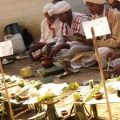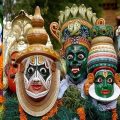Unmasking the 500 Year Old Mask Making Culture of Assam
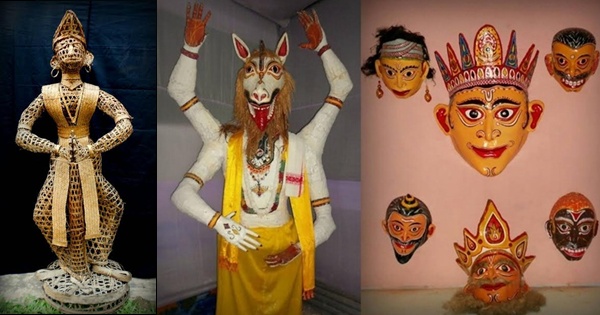
Imagine yourself taking a tranquil sojourn far away from the ennui of your daily life amidst the greenery of Assam! Sounds amazing?And, when you are not going on a food coma with a platter of the exotic delicacies of this land and watching one-horned rhinos perched on elephants’ back, you can weave traditional masks that dates back to 500 years of Vaishnavite culture.
Yes, you got it right! You have heard of the Venetian, Mexican, Chinese, and Brazilian masks, and I am sure you have heard of wooden masks of Sikkim and Chauu masks from Odisha, but have you heard of masks from Assam? Known as mukha, the making of these mask dates back to 500 years in the annals of Assam’s history when Srimanta Sankaradeva propagated his Sankari (Vaishnavite) culture.
To reach out to the masses, Sankaradeva enacted plays known as bhaonas to depict stories from the Ramayana, the Mahabharata and the Puranas. While most of the characters of the demi-gods and demi-goddesses were played by humans, the masks were used by humans essaying the role of demons.

‘Bhaona’ (play). Image Source: AssamInfo.com
When asked, why most of the masks were for demons and evil characters, Rebakanta Mahanta, an octogenarian mask maker revealed, “That’s because Sankaradeva believed that goodness is inherent in all of us, but demons are rare”. That’s positivity!
The 200 plus masks that are at display at Rebakanta Mahanta’s sattra at Khatpar range from a huge mask of Ravana, the king of Lanka to that of Kaliya, the cobra-demon that Lord Krishna slayed. While some masks are full bodied, few portray only the faces. Again some are flexible enabling an evil demon to move his jaws and limbs while challenging a god for a duel in a play! A unique feature of these masks is that they are extremely light-weight even when some of them are as high as six feet!
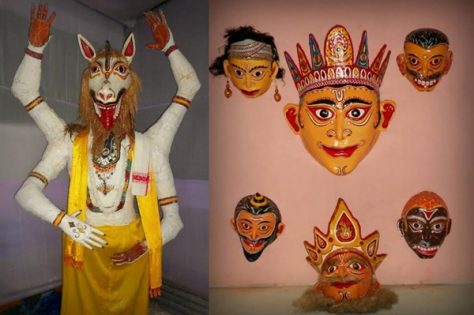
Full bodied mask and face masks
Sattras are Vaishnavite monasteries that were established by Sankaradeva and his disciples. Assam is dotted with these sattras that has kept alive the ancient Sankari culture of Sankaradeva. When in Assam, do visit one of these sattras and do not forget to look for the sanchipat manuscripts of the days of yore. These sattras are living museums that have kept the 500 year old art alive. A paradise indeed for culture buffs! On 15th November, 2000 Sattriya Nritya got its recognition as one of the Classical Dances of India.
What are these masks made of? These are made from locally available raw materials – bamboo, cane, wood, clay, jute, and rags. For the colors, Sangeet Natak Academy award winner Mahanta informed, they use synthetic paints, though earlier they used locally available colors from barks of trees, charcoal, and clay. Isn’t it fascinating?
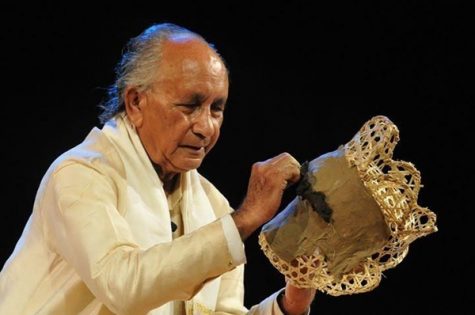
Rebakanta Mahanta creating a mask
For interested students, the octogenarian would be too happy to teach how to create a rainbow of vegetable colors using a few basic natural and organic materials. The art of mask-making is handed over from generation to generation and continues to live through shilp-gurus like Rebakanta Mahanta. Every year art enthusiasts from across the world visit Khatpar Sattra at Sibsagar, Assam to learn the art of making this traditional masks/mukhas of Assam. You can carry miniature versions of these masks as mementos, gifts, or as decorative items.
To be a part of a mask-making workshop, contact Rebakanta Mahanta @ 78967374042.
Getting there:
Jorhat airport or Dibrugarh is connected to Kolkata and Guwahati. From Jorhat, take a bus/taxi to Sibsagar (75kms). From Dibrugarh Airport, Sibsagar is located at a distance of 95 km from the city.
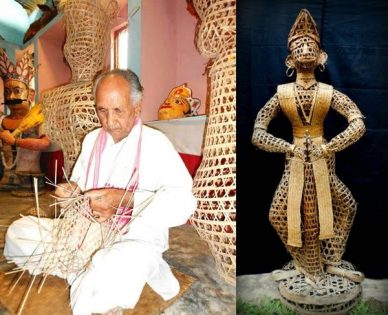
Rebakanta Mahanta creating a mask
Best time to visit:
Khatpar sattra in Sibsagar welcomes visitors throughout the year. Sibsagar is also known as the cultural capital of Assam and houses various museums and temples from the days of the Ahom rulers.
Where to stay:
At Khatparsattra, where you can get a glimpse of the life in a Vaishnavite monastery, or you can search for hotels in Sibsagar.
Where else can you see Mahanta’s mukhas:
1. Srimanta Sankaradeva Kalakshetra, Guwahati
2. Indian Museum, Kolkata
3. Indira Gandhi National Center for Arts, New Delhi.
*With inputs from Goutom Sharma, ex-secretary of Srimanta Sankaradeva Kalakshetra, Guwahati. He is instrumental in creating the mask gallery at Kalakshetra.
Image Courtesy: Monuranjan Mahanta.

